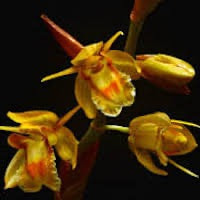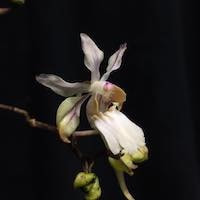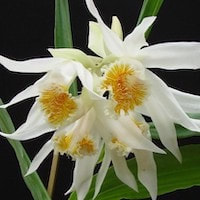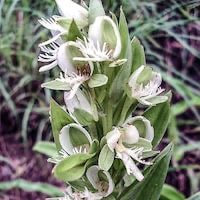MC7- Men's Citrus 7 - King Pear
|
Native Singaporean Orchid notes:
Yellow Bird is a bright orchid known for its stunning flowers that start off with dark orange or maroon petals, turning yellow gradually over a few days. Each flower is about 3 inches wide, growing in clusters of 3 to 4 on a spike. It has earned 11 awards from the American Orchid Society for its exceptional qualities. Despite not being native, its nighttime fragrance adds to its charm, making it a prized addition to our scented orchid collection.
|
Therapeutic Orchid notes:
|
Coelogyne prolifera Lindl. Syn. Coelogyne flavida Hook. f.
The Huanglubeimu Lan, also known as C. prolifera, contains phytochemicals like flavidin and related compounds found in its pseudobulbs. In Nepal, a paste made from these pseudobulbs is applied on the back to relieve backaches and treat boils. This traditional use reflects the orchid's medicinal potential and its role in local healing practices for easing pain and promoting skin healing. |
|
Holcoglossum quasipinifolium (Hayata) Schltr.
The Songye Lan, also known as Qiaochun Lan and Caoshe Lan in China, and Yeludongqing in Taiwan, is a semi-terete leaf orchid found in Taiwan's Central Mountain Range at elevations of 2000–2500 m. It grows on Quercus tree branches. In traditional medicine, the whole plant is used to treat conditions by dispelling wind and dampness, relieving joint pain, and combating infections like malaria and sore throat. Its versatile medicinal uses highlight its value in traditional healing practices. |
|
Thunia alba (Lindl.) Rchb. f. Thunia marshalliana Rchb. f., Phaius albus Lindl.; P. marshallianus Rchb.f.; N.E. Brown
The Sun Lan, known as the Bamboo Orchid, blooms in June in China and from March to August in Bhutan, Darjeeling, and Sikkim. It thrives on rocks or in tree hollows in rocky soil across India, Nepal, Bhutan, Myanmar, and other regions. Chinese herbalists use the whole plant to nourish yin, aid lungs, clear phlegm, and heal fractures. In Nepal, it's applied as a paste to set fractures, showing its valued medicinal uses. |
|
Ischnogyne manadarinanum (Kranzl.) Schltr.
The Shoufang Lan, known as the Slim House Orchid, blooms from May to June. This orchid grows on rocks in forests and ravines at elevations of 700–1500 m in several Chinese provinces. In traditional Chinese medicine, plants sourced from Shanxi, Hubei, and Sichuan are used to treat tuberculosis-related coughing and bronchitis. Its potential in addressing respiratory conditions highlights its medicinal value in treating these ailments. |
Other scent note
Scentopia Library Reference ingredient
Bitter Orange - Check details at Scentopia's scent library
Download the guided mediation that works best with this Orchid fragrance oil
| men_citrus_essential_oil_orchi_00007.mp3 | |
| File Size: | 114032 kb |
| File Type: | mp3 |




